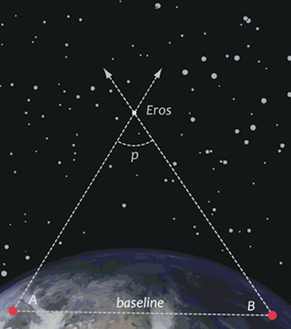Background

Astronomers often use parallax to measure distances to objects within our solar system, such as comets and asteroids. To measure distances to these kinds of objects, astronomers use a different method to measure parallax than the one described in the previous section. The reasons for this are 1) you want to know the instantaneous distance to an object, and if you had to wait six months, it may be a completely different distance away from Earth, and 2) many comets and asteroids are moving quickly through our solar system, so they may not be in it after six months.
So, to measure parallax to objects within our solar system, astronomers use topocentric parallax, which is when you view the same object from different places on the Earth simultaneously.
Topocentric parallax was used to determine the distance to the Sun from Earth using the transit of the asteroid Eros in 1931. At the time, Eros was within Mars’ orbit and in opposition with the Sun, meaning it was behind the Sun from Earth’s point of view. When it was viewed simultaneously from two points on the Earth, the apparent position of Eros compared to the background stars was different. By observing Eros as it orbited around the Sun, astronomers could calculate the distance to Eros using parallax. Once the distance between Eros and Earth was established, the distance to the Sun was calculated from Kepler’s Third Law.

